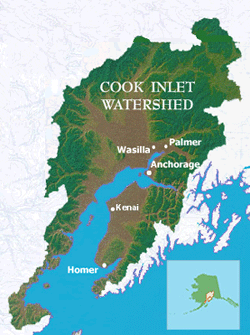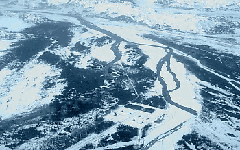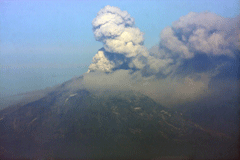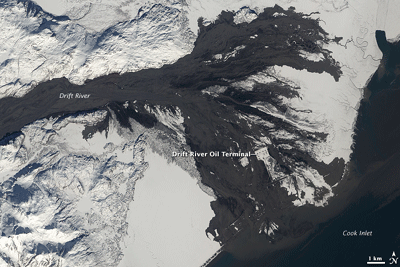Volcano, Oil and Fish
Air Date: Week of April 24, 2009

Cook Inlet (Courtesy of Cook Inletkeeper)
Chevron’s Drift River oil terminal is located downstream from the Mount Redoubt volcano and upstream from Cook Inlet, an important habitat for salmon and whales. Bob Shavelson, Executive Director of the Cook Inletkeeper, tells host Jeff Young authorities are not prepared to clean up a major oil spill in the region if an accident occurs.
Transcript
YOUNG: Though its eruptions have subsided, Alaska’s Mount Redoubt continues to spew volcanic gasses and ash. That has some locals worried – because below the volcano is Cook Inlet, and a Chevron oil storage facility.
Bob Shavelson is the Executive Director of Cook Inletkeeper, a non-profit organization dedicated to protecting the Inlet and its watershed. He joins me from a studio in Homer, Alaska.
Mr. Shavelson, welcome to Living on Earth.
SHAVELSON: Thank you, Jeff. My pleasure to be here.
YOUNG: Now, give us a feel for the lay of the land here. We have this volcano, which is quite active. About how far from the volcano to this oil facility?

The dark pathways of a lahar move past the Drift River Oil Facility pictured here as the whit rectangles in the middle of the photo. This photo is from 1990, Mt. Redoubt erupts approximately every 20 years.
SHAVELSON: Well, its approximately seventeen miles from the oil tank farm that’s operated by Chevron to the peak of Mount Redoubt, but the tank farm sits in the drift river valley which provides a conduit up to the volcano, so when you get the pyroclastic flows from the eruption, they produce these lahars which the mud and debris and water and ice flows that come down. They’ve been described by experts as moving walls of cement.
YOUNG: I guess you’re putting two and two together here and thinking boy, if that hits the oil facility, that’s a bad situation.

Since March 22, 2009 Mt Redoubt has erupted at least 19 times. (Photo: Thomas Kerns, Courtesy of NASA)
SHAVELSON: Absolutely. You know Cook Inlet sits in the Pacific Ring of Fire, we’ve got five active volcanoes in our area. We’re also the oldest oil and gas producing region in the state. So, its not like these situations haven’t arisen before. In fact, in 1989 and ’90, we had the exact same scenario where and eruption of Mount Redoubt threatened this very same terminal and posed a significant threat to the fisheries and the people they support in Cook Inlet.
YOUNG: And tell me more about Cook Inlet. Why is the water there so important?
SHAVELSON: Cook Inlet supports all five species of wild Pacific salmon and the salmon and halibut fisheries here support countless Alaskans. It’s very important for the economy here.
YOUNG: Do we know why Chevron put the facility there in the first place? It seems, you know, if you knew the nature of volcanoes, you wouldn’t want to be right there.

Cook Inlet (Courtesy of Cook Inletkeeper)
SHAVELSON: [Laughs] That’s an excellent question. I’ve heard it probably hundreds of times in the past couple weeks. The facility was sited in the 1960s. And, you know, this was before a lot of our major environmental legislation, the Clean Air Act, the Clean Water Act had been installed and there was a different mindset then. From what I understand, it was simple geography. They wanted access to deeper water and they also wanted to be out of the heavy ice and tide conditions that you find further north in the inlet.
YOUNG: And how much oil are we talking about? How much oil is kept in those big tanks?
SHAVELSON: It fluctuates, and one of the problems that we have with this situation was that prior to the eruption on March 22nd, we weren’t able to find out how much oil was in the tanks. In fact, Chevron refused to reveal it and they cited the Homeland Security Act. And they also refused to reveal something called a volcano readiness plan that presumably would have told how they were going to deal with the catastrophic spill from this facility, but then on March 22nd when the volcano erupted, a press release went out and we learned finally that there was 6.3 million gallons of oil sitting at the base of the volcano. Just about half of the volume of oil that spilled with the Exxon Valdez
YOUNG: And if there were and accident of this nature, how would they deal with an oil spill?

The recent eruption of Mt. Redoubt sent a volcanic avalanche, or lahar, downstream to the Drift River Valley where a Chevron oil storage facility is
located. (Courtesy of NASA)
SHAVELSON: Well, that’s a really good question, because from our perspective there’s no technology that would be suitable to address a spill in this scenario. We already know that it’s virtually impossible to clean up oil and ice. When you think about a lahar induced oil spill where you would have mud and debris and ice and these things pushing these oil tanks and all the oil in them out, we don’t have the technology, the spill removal technology, to address those things.
YOUNG: What do you look to as a more permanent solution here?
SHAVELSON: We would prefer to see a pipeline that would reduce the risk of shipping the oil.
YOUNG: Now, I guess if I were Chevron, responding to this, I would say, look, we’ve been here forty years. And we haven’t had an accident. Therefore that proves we’re safe. How do you respond to that?

Location of Redoubt volcano, in relationship to surrounding towns, roads, and other volcanoes. (Image: Janet Schaefer, Courtesy of the Alaska Volcano Observatory / Alaska Division of Geological & Geophysical Surveys)
SHAVELSON: Well, that’s what we heard from the oil industry prior to Exxon Valdez. And one of the lesson we learned from the Exxon Valdez is that you can’t be complacent. You have to plan, you have to have the resources available to address these contingencies that we know that are there. The 1989-1990 eruption of Mount Redoubt showed very clearly the risk posed by this scenario. Yet we did literally nothing to address them, so we’ve had a repeat situation here in 2009.
YOUNG: Bob Shavelson is executive director of the Cook Inletkeeper, and he’s been talking to us about volcanoes, oil and water and why he hopes they never mix, right?
SHAVELSON: And fisheries.
YOUNG: And fisheries.
[LAUGHING]
YOUNG: Thanks very much for your time – I appreciate it.
SHAVELSON: Thank you, Jeff. My pleasure.
YOUNG: Now we contacted Chevron - they sent a statement. It reads - in part:
“Chevron will determine if there is a safe and economically viable method for shipment of crude oil from the Cook Inlet operations to market without relying on the storage tanks located at the Drift River Terminal.”
Links
Living on Earth wants to hear from you!
Living on Earth
62 Calef Highway, Suite 212
Lee, NH 03861
Telephone: 617-287-4121
E-mail: comments@loe.org
Newsletter [Click here]
Donate to Living on Earth!
Living on Earth is an independent media program and relies entirely on contributions from listeners and institutions supporting public service. Please donate now to preserve an independent environmental voice.
NewsletterLiving on Earth offers a weekly delivery of the show's rundown to your mailbox. Sign up for our newsletter today!
 Sailors For The Sea: Be the change you want to sea.
Sailors For The Sea: Be the change you want to sea.
 The Grantham Foundation for the Protection of the Environment: Committed to protecting and improving the health of the global environment.
The Grantham Foundation for the Protection of the Environment: Committed to protecting and improving the health of the global environment.
 Contribute to Living on Earth and receive, as our gift to you, an archival print of one of Mark Seth Lender's extraordinary wildlife photographs. Follow the link to see Mark's current collection of photographs.
Contribute to Living on Earth and receive, as our gift to you, an archival print of one of Mark Seth Lender's extraordinary wildlife photographs. Follow the link to see Mark's current collection of photographs.
 Buy a signed copy of Mark Seth Lender's book Smeagull the Seagull & support Living on Earth
Buy a signed copy of Mark Seth Lender's book Smeagull the Seagull & support Living on Earth

